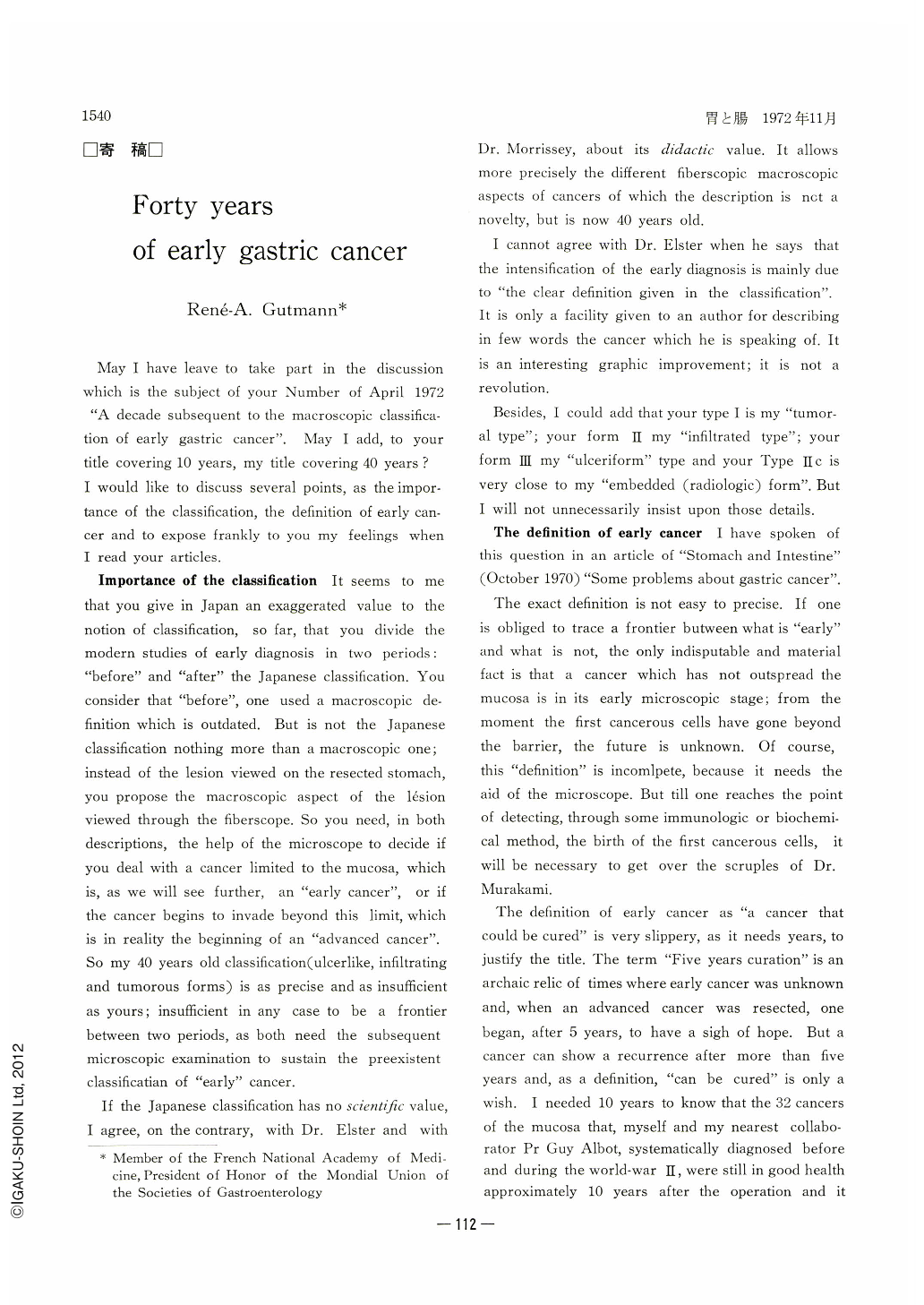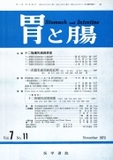Japanese
English
- 有料閲覧
- Abstract 文献概要
- 1ページ目 Look Inside
貴誌1972年4月号「早期胃癌肉眼分類起草10年」の主題である討論に参加することをお許し願いたい.また,10年という表題に,40年という私のタイトルを追加させて頂きたいものである.私は分類の重要性,早期胃癌の定義など,二三の点を検討し,併せて,貴誌の読後感を率直にのべてみたい.
分類の重要性
私の感じでは,日本の方たちは分類というものの評価が大袈裟だと思う.そのため,早期診断の新しい研究まで,日本式分類「以前」と,「以後」の,二つの時期に分類されてしまった.また,「以前」には,もう時代おくれになった肉眼的定義が使われていたとお考えのようだ.しかしながら,日本式分類は,まさしく肉眼分類そのものではないだろうか?切除胃で観察した病変の代りに,ファイバースコープを通して眼でみた病変の,肉眼的外観を提案するだけのことではないのだろうか?どちらの記載法にしろ,顕微鏡の助けなくしては,粘膜内に限局する癌(後でわかるように「早期癌」)に関係があるのか,癌が境界を越えて浸襲しはじめているのか(これはまさに「進行癌」のはじまり),決定でき得ない.したがって,私が40年前に行なった分類(ulcer-like,infiltrating,tumorous forms)は,日本式分類に劣らず正確であり,それと同様不十分でもある.なぜなら,両方とも「早期癌」に先がけて存在すべき,分類の確実さを立証するためには,ひきつづいて,顕微鏡的検査を必要とするので,両時期間の新分野となるには不十分なのである.
May I have leave to take part in the discussion which is the subject of your Number of April 1972 “A decade subsequent to the macroscopic classification of early gastric cancer”. May I add, to your title covering 10 years, my title covering 40 years? I would like to discuss several points, as the importance of the classification, the definition of early cancer and to expose frankly to you my feelings when I read your articles.
Importance of the classification It seems to me that you give in Japan an exaggerated value to the notion of classification, so far, that you divide the modern studies of early diagnosis in two periods : “before” and “after” the Japanese classification. You consider that “before”, one used a macroscopic definition which is outdated. But is not the Japanese classification nothing more than a macroscopic one; instead of the lesion viewed on the resected stomach, you propose the macroscopic aspect of the lésion viewed through the fiberscope. So you need, in both descriptions, the help of the microscope to decide if you deal with a cancer limited to the mucosa, which is, as we will see further, an “early cancer”, or if the cancer begins to invade beyond this limit, which is in reality the beginning of an “advanced cancer”. So my 40 years old classification (ulcerlike, infiltrating and tumorous forms) is as precise and as insufficient as yours; insufficient in any case to be a frontier between two periods, as both need the subsequent microscopic examination to sustain the preexistent classificatian of “early” cancer.
If the Japanese classification has no scientific value, I agree, on the contrary, with Dr. Elster and with Dr. Morrissey, about its didactic value. It allows more precisely the different fiberscopic macroscopic aspects of cancers of which the description is not a novelty, but is now 40 years old.
I cannot agree with Dr. Elster when he says that the intensification of the early diagnosis is mainly due to “the clear definition given in the classification”. It is only a facility given to an author for describing in few words the cancer which he is speaking of. It is an interesting graphic improvement; it is not a revolution.
Besides, I could add that your type I is my “tumoral type”; your form Ⅱ my “infiltrated type”; your form Ⅲ my “ulceriform” type and your Type Ⅱc is very close to my “embedded (radiologic) form”. But I will not unnecessarily insist upon those details.
The definition of early cancer I have spoken of this question in an article of “Stomach and Intestine” (October 1970) “Some problems about gastric cancer”.
The exact definition is not easy to precise. If one is obliged to trace a frontier butween what is “early” and what is not, the only indisputable and material fact is that a cancer which has not outspread the mucosa is in its early microscopic stage; from the moment the first cancerous cells have gone beyond the barrier, the future is unknown. Of course, this “definition” is incomlpete, because it needs the aid of the microscope. But till one reaches the point of detecting, through some immunologic or biochemical method, the birth of the first cancerous cells, it will be necessary to get over the scruples of Dr. Murakami.
The definition of early cancer as “a cancer that could be cured” is very slippery, as it needs years, to justify the title. The term “Five years curation” is an archaic relic of times where early cancer was unknown and, when an advanced cancer was resected, one began, after 5 years, to have a sigh of hope. But a cancer can show a recurrence after more than five years and, as a definition, “can be cured” is only a wish. I needed 10 years to know that the 32 cancers of the mucosa that, myself and my nearest collaborator Pr Guy Albot, systematically diagnosed before and during the world-war Ⅱ, were still in good health approximately 10 years after the operation and it needed 40 years to learn that at least 3 of them were still living, more or less 80 years old. May be we had luck, but all our mucous cancers were cured. But it is not always possible to wait so long a time to attain a definition!
I don't share the views of Dr. Frik when he writes that “the efforts of European authors”“more than 3 decades ago”were not followed by important consequences. Though I am not included in those innominated European authors, because I belong to“4 decades”, I would like to answer. After the “`princeps”descriptions in my book of 1939 of intramucous ulceriform cancer, muco-erosive cancer, conjunctive cancer, etc, all these, the first systematically detected in the world, after also the “princeps”histological study in the same book, with 150 pages and 132 illustrations written by Ivan Bertrand, (whose remarkable and “princeps”descriptions seem to be unknown by the Japanese pathologists) a new point of view appeared, at least in France and also in some neighbouring countries: the radiologists began to pay attention to the little signs I had described; the physicians began to consider. The radiological finding and to check them through a therapeutical test; the surgeons began to learn that they should not confide themselves in their operatories finding and not to perform a gastrectomy, as it is proved by my several publications about “gastric cancers invisible to the surgeon”. As to the early diagnosis, I can say that, in France, since many years, nobody feels the neces sity to publish a case of early cancer, except if it has some special interesting character, because it is generally considered to be a settled problem. Only after the generalisation of gastrobiopsy, one assisted to a special and temporary increase of publications.
I cannot also share Dr. Frik's opinion when he writes that, “3 decades ago”, “only highly specialised and experienced radiologists were able to demonstrate early cancer”. The reason why is that I am not myself a radiologist and that, round me, my assistants and my pupils learned my very simple method. Our diagnosis was made upon the various and not selected radiographs we saw, brought by our non-specialised patients, and I may add that, before the world-war Ⅱ, our radiographs were not so perfect as today and, of course, by far inferior to the beautiful radiographs you publish in this Journal. When one learns to see and to attach importance to the little signs I described, it is easy not to miss them afterwards. I always emphasize that the early diagnosis of gastric cancer is not a conjuror's trick.
May I endly write without offending my Japanese colleagues that nearly all that is published “since 10 years”in Japan is described in full in my first book published in 1939, not speaking of my less complete books of 1956 and 19671). This affirmation concerns the description of early cancer. Of course you have introduced many extremely important improvements in the technic. My old gastroscope was archaic in comparison with your splendid fiberscopes; the gastrophotographic views that I obtained since 1932 (I have sent recently some specimens to Japanese friends) were not satisfying enough to help me regularly: so I reached the opinion-which is still mine-that gastrophotography is incomparably interesting to collect iconographic documents, but has no worth for the diagnosis; it gives the macroscopic view of a lesion, but this view is unable to decide firmly, in beginning lesions of course, whether it is malignant or benign. I abandoned quickly my cytologic trials and all these “helps”which are now splendidly performed in Japan. I used only radiographic interpretation and I asked essentially for the full stomach method for the curvartures and, later on, used a mixture of baryum, egg-yolk and an effervescent matter for the faces; But there were bubbles to lessen the efficacy of a method in which the last book of my friend Professor Shirakabe reveals a master.
One fact remains; you have brought unequalled improvements to the early diagnosis of gastric cancer, you have made it a practically usual method. Your mass-surveys are also unequalled (so is also the presentation of this Journal). But may I humbly beg you, in Japan, not to forget that, with its radiologic, morphologic and histologic details, the early gastric cancer has been described in France 40 years ago?

Copyright © 1972, Igaku-Shoin Ltd. All rights reserved.


